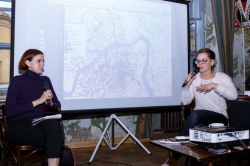What's the purpose of fences in the city, and how did the "overfencing" problem come to be?
Fences are typically used to protect lawns and enclose traffic areas. Nowadays, there are many erratic fencing solutions in the city, like when lawn fencing is placed right behind the already existing traffic barriers. The problem here is that different departments of the city administration are responsible for different kinds of fencing, and their actions are often mismatched.
Representatives of the General Administration for Traffic Safety claim that placing fences improves road safety; in reality, it doesn’t. Sometimes, fencing even causes emergency situations, and those are not only cases when pedestrians climb fences and cross roads in unexpected places. Sometimes, drivers who have just parked have to walk along roads in order to get to the sidewalks, which is also unsafe. What is more, there still hasn't been any reliable scientific evidence that placing fences contributes to a lower accident rate.
Lawn fences are popular with municipal officials. In fairness, it must be said that it is the citizens who often ask to fix lawns with fencing in order to save them, as otherwise, car owners park their cars there. Still, city officials often overdo it and start "protecting the lawns" where there's no need to. Oftentimes, they don't care for the pedestrians' opinions and see them as robots of some kind. For instance, they assume that pedestrians are comfortable with 90-degree turns, though it is obvious that most prefer to cut corners, which is often dealt with by placing even more fences.

How do pedestrians feel about fences?
Many citizens are content with using fences to prevent people from walking on lawns, as they consider it a very important problem. On the whole, we can say that there are several kinds of people. The most considerate ones would never trespass on a lawn. Still, there are the inconsiderate pedestrians that would do that, and the most inconsiderate: those who are the first to make their way across lawns, thus encouraging others to do the same. So, is it the inconsiderate pedestrians who we are to blame? No. They move towards some goal, but their goal has nothing to do with lawns. If we see that whole crowds of people move across a particular lawn, it means that there's some point of attraction nearby. My colleague Egor Smirnov has developed an algorithm that models the pedestrians' movements with regard to their behavior and helps design comfortable pedestrian infrastructures. The algorithm simulates the behavior of virtual pedestrians and forecasts the best places to place footpaths. It also points out mistakes in planning.
Another thing to be considered is the pedestrians’ individual psychology: for instance, which angles they will consider cutting and which they won't. In an almost 30-years old document with recommendations for planning footpaths by the Central Institute for Research and Design of the Ministry of Construction and Housing, they estimate the border value for such an angle at 30 degrees. Having used the data from a last year's Master's thesis that analysed over a hundred of places with spontaneous trails, we've estimated the angle which the pedestrians are likely to cut at 38 degrees. We've updated the algorithm with regard to these findings, and can now forecast the possible places for footpaths even better.
On the whole, we shouldn't prevent people from walking where it's most comfortable. It is much better to make forecasts and plan everything properly in advance. A meter of fence costs about 3,000 rubles. I believe that the city administration has many other things to spend this money on.

The issue with cars is a lot more complex. On one hand, car owners are prohibited from parking cars on lawns, and if the legal system is working fine, no one would park on lawns after getting fined several times in a row. Unfortunately, municipal officials prefer to deal with the problem by placing fences rather than issuing fines, which is quite strange, as those fines go into the city budget. Still, even that doesn't motivate them. This is a very ambiguous case, as placing fences seems like an ineffective way to spend resources, but if we don't, car owners start to park on lawns. Therefore, there's no choice but to protect them. Surely, there are other choices of protective objects - concrete semispheres (though they are never fixed into the road, and car owners often move them), and the less popular, but the more economically efficient poles. The poles are cheaper, but are rarely used, as there other issues associated with such a solution - for one, they infringe fire safety by preventing fire trucks from approaching the territory. Still, in all these cases we are faced with a problem of having to resort to placing objects that wouldn't have been necessary if the legal system worked fine.
Let's say a particular citizen is against having a fence around a nearby lawn, especially if it gets broken all the time. What can they do about it?
In 2013, a spontaneous pedestrian crossing emerged on Utochkina Street near Komendantsky Avenue. People ran across the highway, and so authorities placed fences, then people disassembled sections of these fences to make way, and the authorities repaired them. Lots of money was spent on repairs, but people still did as they liked. One has to understand that the width of the street there was designed for a traffic speed of 100 km/h, which is absurd, as the speed limit in the city is 60 km/h. At some point, we decided that there has to be a different solution to this problem. In order to substantiate our appeal to the administration, we conducted a study: we found a member of the Beautiful St. Petersburg project who lived in an apartment overlooking the street, placed a camera, and counted the number of people who used the crossing in a day's time. It turned out that there were over 17,000 of them. Due to their large number, the drivers who used the street got used to slowing down before the crossing, and there were no fatal accidents in this area. We also counted the number of people who used the pedestrian crossing some 70-100 meters away that was fixed with traffic lights - about 10,000 a day. So, the issue here was about having two pedestrian crossings. In several months, our report made it to the governor. In the end, a new pedestrian crossing was created on the location of the spontaneous trail, but the former one was eliminated. This is just another example of how the city officials care about regulations only and not about the people, even though there's no regulation that forbids placing two sets of traffic lights not far from each other. Now, a new spontaneous trail has emerged. People have to understand that it is possible to influence the situation, but you have to keep in mind that changes can take ages, and the results can be not as good as you expected them to be. Still, as long as there's no action being taken, this absurd "overfencing" will go on.

Is there an aspect of corruption to this problem?
There is a hypothesis that there is, i.e. that someone has a plant for manufacturing X-shaped fences. With that many streets, the production plan can be quite extensive. The fun part here is that when you try persuading the city committees, they answer that it is the General Administration for Traffic Safety that orders them to place fences, and they are in no position to argue. Therefore, it might be someone from this entity who profits from placing fences. Unfortunately, no major media outlet in St. Petersburg has investigated the matter so far.
In 2017, the Beautiful St. Petersburg community declared a war on "overfencing". How are the results?
We never declared a "war", as you can't declare war on a phenomenon that doesn't have anyone in particular behind it. What we did was launch a campaign against these erratic activities. I can't say that we were successful, as city officials continue to place fences. No reasonable arguments work for them, they just continue talking about safety like it’s some mantra. This spring, the Open Data Hackathon took place in St. Petersburg, its winning project being the one that analyzed the open statistics by the Ministry of Internal Affairs and defined danger zones on roads. We came up with the idea of using the statistics for three years to collect data on every location where fences have been placed in order to study the dynamics of traffic accidents, i.e. whether placing fences really has any effect. We hope that it can help us to prove that placing fences is an ineffective solution. What is more, most people forget that fences are quite fragile, and cars often break through them. There was also one case in Moscow when elements of their construction caused lethal damage to people when a bus broke through a fence. I.e. the fence didn't stop the car, but acted as a damaging agent. We hope that raw numbers would be enough to persuade the officials. You have to understand that it all depends on us, as well - as long as we keep silent or argue on the Internet, nothing is going to change. If we start to channel our indignation into simple efficient actions, like sending appeals, the city officials will have formal grounds to do something. Everything begins with us, the civic society, though it has recently been focusing on the Internet only and doesn't want to change that.

What are the services that one can use to attain the desired results?
The simplest service by Beautiful St. Petersburg uses a script, so most city committees block appeals sent from its website. Still, they never abolished the very format of electronic appeals. There is also the electronic reception of St. Petersburg Administration, which is an official instrument for filing appeals, so the officials are obliged to react to those.
By the way, you shouldn't confuse it with the Our St. Petersburg webportal: what you file there are not official appeals, but only messages that officials can ignore. Thus, we advise you to file appeals via the official electronic reception of St. Petersburg Administration. Everything else is just blowing off steam.





